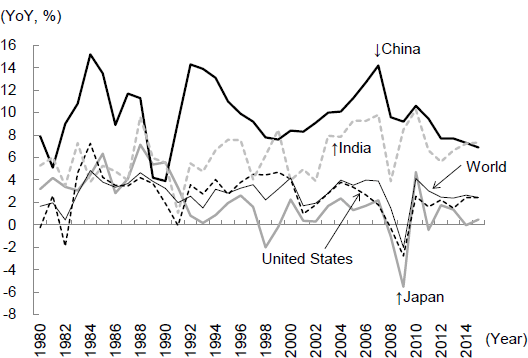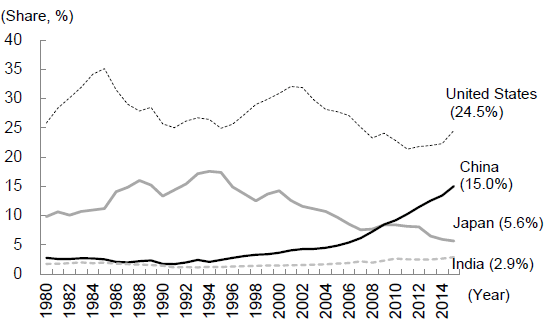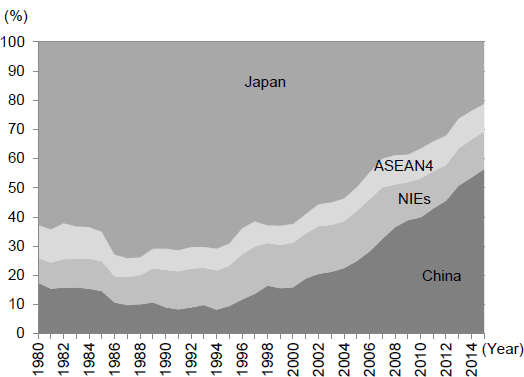The Chinese economy has entered a high-growth period since shifting to reform and open-door policies in the late 1970s with the average annual growth rate from 1980 to 2015 reaching 9.7%, which is significantly higher than those of most major countries and the world as a whole (Figure 1). As a result, China's gross domestic product (GDP) increased 36.3 times from $302.9 billion in 1980 to $10,982.8 billion in 2015, and its share of the world's GDP (in nominal terms, converted to U.S. dollars) rose from 2.7% to 15.0% (Figure 2). Over the same period of time, China's per capita GDP also increased from $306.9 to $7,989.7 (26.0 times), and its ranking in the world rose from 127th among 139 countries and regions to 76th among 189 countries and regions (Note 1). China has become the world's second largest economy after the United States in terms of GDP, and its per capita GDP has reached the level of a middle-income country.
― Comparison with Major Countries and the World ―

― Comparison with Major Countries ―

Here, I will highlight the shift in global economic power caused by the rise of China by comparing changes in GDP and per capita GDP of China from 1980 with those of major countries such as India, Japan, and the United States (Note 2) (Table 1).
| GDP (billion dollars) | Population (million people) | Per capita GDP (dollars) | ||||
|---|---|---|---|---|---|---|
| 1980 | 2015 | 1980 | 2015 | 1980 | 2015 | |
| China | 302.9 | 10,982.8 | 987.1 | 1,374.6 | 306.9 | 7,989.7 |
| India | 189.4 | 2,090.7 | 685.7 | 1,292.7 | 276.3 | 1,617.3 |
| Japan | 1,087.0 | 4,123.3 | 116.8 | 126.9 | 9,308.9 | 32,485.5 |
| US | 2,862.5 | 17,947.0 | 227.6 | 321.6 | 12,575.6 | 55,805.2 |
| GDP ratio (%) | Population ratio (%) | Per capita GDP ratio (%) | ||||
|---|---|---|---|---|---|---|
| 1980 | 2015 | 1980 | 2015 | 1980 | 2015 | |
| China/India | 159.9 | 525.3 | 144.0 | 106.3 | 111.1 | 494.0 |
| China/Japan | 27.9 | 266.4 | 845.3 | 1083.0 | 3.3 | 24.6 |
| China/US | 10.6 | 61.2 | 433.6 | 427.4 | 2.4 | 14.3 |
| Source: Compiled by the author based on IMF, World Economic Outlook Database, April 2016 | ||||||
Like India, China has an enormous population, but for a long time, its GDP was not very large because of its low per capita GDP. China's per capita GDP ($306.9) was nearly the same as that of India ($276.3) in 1980, but by 2015 it grew to 4.9 times that of India ($1,617.3). On the other hand, while the population of India increased from 686 million in 1980 to 1.293 billion in 2015 (up 88.5%), a pace of growth much faster than that of China (up 39.3% from 987 million to 1.375 billion), its GDP (= per capita GDP x population) did not grow as much as China's. This resulted in the GDP gap between the two countries widening from 1.6 times to 5.3 times over this period. While India is expected to become the world's most populous country, overtaking China at some point in the future, China is one step ahead of India in becoming an economic superpower. With India's real GDP growth rate surpassing that of China in 2015, hope is rising that India may become a new engine for the world economy, but for some time to come the driving force of India will be limited because of its still low GDP.
The power shift from Japan to China in East Asia has also been remarkable. China's GDP was only 27.9% of Japan's in 1980, but it surpassed Japan in 2009 to become the second largest in the world after the United States. The gap in GDP between the two countries widened since to 2.7 times in 2015 due to the weaker yen and the stronger yuan, in addition to the gap in their growth rates. China's per capita GDP also went from being only 3.3% of Japan's in 1980 to 24.6% in 2015. Consequently, Japan's share of GDP of the entire East Asian region (Japan, NIEs, ASEAN4, and China) fell from its peak at 74.1% in 1987 to 21.2% in 2015, while China's share rose from the bottom at 8.3% in 1994 to 56.5% in 2015 (Figure 3). Thanks to the rise of China, the GDP of East Asia has surpassed those of the United States and the European Union (EU) (Table 2).

| 1980 | 2000 | 2015 | ||
|---|---|---|---|---|
| United States | GDP (billion dollars) | 2,862.5 | 10,284.8 | 17,947.0 |
| Share of the world GDP (%) | 25.8 | 30.9 | 24.5 | |
| EU | GDP (billion dollars) | 3,755.4 | 8,829.6 | 16,220.4 |
| Share of the world GDP (%) | 33.8 | 26.5 | 22.2 | |
| East Asia | GDP (billion dollars) | 1,733.5 | 7,588.0 | 19,451.6 |
| Share of the world GDP (%) | 15.6 | 22.8 | 26.6 | |
| Note: The EU covers the current 28 member countries at all points in time. East Asia refers to Japan, China, NIEs (South Korea, Taiwan, Hong Kong, and Singapore), and ASEAN4 (Indonesia, Malaysia, the Philippines and Thailand). | ||||
| Source: Compiled by the author based on IMF, World Economic Outlook Database, April 2016. | ||||
Although China's GDP is now the second largest in the world after the United States, its per capita GDP has yet to exceed the level of a middle-income country. People have started to wonder when China's GDP will surpass that of the United States to become the world's largest, and when its per capita GDP will reach the level of a developed country.
In 1980, China's GDP was only 10.6% and its per capita GDP was only 2.4% of that of the United States, but rose to 61.2% and 14.3%, respectively, by 2015 (Note 3). The real GDP growth rate of China is expected to be much higher than that of the United States in the years ahead. With the yuan expected to appreciate moderately against the dollar, reflecting an improvement in the international competitiveness of Chinese products, the GDP gap between China and the United States will narrow further. China's GDP is likely to become the world largest, surpassing that of the United States, in about 10 years. However, even when that day finally comes, China's per capita GDP will remain less than one-fourth of that of the United States given the difference in population. It will take much longer time for China's per capita GDP to reach the level of a developed country.


